When Verizon made a big splash launching its LTE Advanced network last week, we pointed out that this was actually the launch of a marketing campaign, not a new technology.
We noted that T-Mobile, Sprint, and AT&T have all also deployed LTE Advanced carrier aggregation to various extents, and said:
"LTE Advanced is indeed awesome technology, but it is not Verizon exclusive, and it is not new."
T-Mobile yesterday published a blog post from CTO Neville Ray pointing this out - claiming that T-Mobile is the actual true leader in deploying LTE Advanced technologies.
Neville went on to announce two major technological initiatives:

"I was cracking up at Verizon’s breathless “LTE Advanced” announcement last week. Really? LTE Advanced? That same technology (2 channel carrier aggregation) has been available to T-Mobile customers since 2014 , and we’ve already rolled out 3 channel carrier aggregation too. These advanced technologies are already live for T-Mobile customers in 425 cities across the country. ...
Look, in reality, carrier aggregation is not new. It’s so 2014. That sound you heard from T-Mobile last week was a great big yawn. We’re already on to the next big thing.
Today, I’m proud to announce that we’re first (again) to introduce new technology that delivers a massive 2x speed boost to customers. 4x4 MIMO (multiple input, multiple output) doubles the number of data paths between a cell site and your phone. Double the paths = up to double the speed than before!
This new advanced technology is available NOW in 319 cities. Customers with the Samsung Galaxy S7 and S7 Edge will be able to use this new technology with a software update later this month, and more phones will support it soon.
But, we’re not stopping there. Today, we’re also first to launch another new technology – 256 QAM (quadrature amplitude modulation) for downloads and 64 QAM for uploads. These new technologies increase the number of bits delivered per transmission for even faster speeds. In fact, combined with 4x4 MIMO, 256 QAM delivers download speeds up to a blazing fast 400 Mbps."
That sure is a loud and boastful yawn!
But only if you have the absolute latest mobile devices will you be able to take advantage of all this new technology.
4x4 MIMO: Four Antennas in a Phone?!
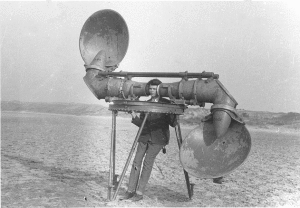
All LTE devices actually support a technology known as MIMO (multiple in, multiple out) to enable cellular devices to use two antennas working together to better listen to the tower.
And when the signal is strong enough, MIMO enables two simultaneous data streams so that speeds can double.
4x4 MIMO takes this to the next level - using four antennas instead of two!
With a 4x4 compatible tower and device communicating with each other, four antennas working together on each end of the transmission can actually quadruple speeds.
And even with older 2x antenna LTE devices, cell towers with 4x antennas are better able to pick up the upstream signal too - even if four-way turbo mode is impossible.
T-Mobile is claiming to be the first US carrier to deploy 4x4 MIMO, with a surprisingly large list of cities with the technology deployed.
But designing a cellular device with four internal antennas is fiendishly complicated. The only current device that support 4x4 MIMO on the US market is the Samsung S7 and S7 Edge.
Presumably other flagship devices will be rolling out with support in the very near future too.
To better understand how MIMO works and why it is such an incredible technology, read our featured member's only guide:
256-QAM - Quadrature Amplitude Modulation?!!?

The other new LTE Advanced technology that T-Mobile is claiming to be the first to deploy is known as 256-QAM.
Quadrature Amplitude Modulation (QAM) is a mouthful to say - and it is the technical process behind how digital data is encoded into an analog radio signal for cellular (or Wi-Fi) transmission.
By way of analogy - you can think of QAM as an alphabet - and just like you use a keyboard to type words on a screen using 26 letters, the QAM process "types" into the airwaves using an alphabet of encoded signals.
Current generation LTE devices work with 64-QAM, which means that 6-bits (analogy: 64 different keys on a keyboard) are encoded into the signal. When the signal from the tower is noisy or weak, the radio can switch to 16-QAM (16 keys on a keyboard) or even 4-QAM (just four keys) - slowing things down, but at least staying connected.
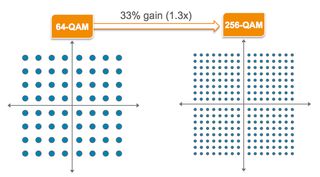
LTE-Advanced introduces a new faster option, 256-QAM, which encodes 8-bits (256 possible values) into the signal. This means, all things being equal, double the performance of a 16-QAM transmission, or 33% faster than 64-QAM.
The key to enabling 256-QAM is having a strong pristine signal - otherwise the LTE network will dial back to a lower raw speed.
But in areas that can support it, having this raw speed boost is very welcome.
T-Mobile is claiming that 256-QAM support is live in half of its cell towers today, and it will be deployed to every T-Mobile tower nationwide by the end of October.
But as with 4X4 MIMO, you'll need a compatible device to see any benefits. The Samsung S7 and S7 Edge are the first phones on the US market confirmed to have 256-QAM compatible hardware, with software updates enabling the feature going out next month.
Other new flagship phones and hotspots will likely also launch with 256-QAM support, but most older devices will be left behind.
Uploads Too: 64-QAM
T-Mobile also announced that they will be supporting the LTE Advanced option of 64-QAM for the upload channel from your phone or hotspot back to the tower, up from the currently common 16-QAM.
With compatible devices (and a clean and strong cell signal) this means that upload speeds can increase by 50%, all other things being equal.
Upload performance is often neglected - it is great to see some major improvements happening here.
T-Mobile: A Technology Leader, But Coverage Still Lags

T-Mobile deserves to crow about how quickly it has been able to bring the most advanced cellular technologies to market. Rolling out 256-QAM and 4x4 MIMO nationwide is indeed an impressive achievement.
But T-Mobile is also starting to crow about having caught up with Verizon in coverage area too - but this boasting is NOT warranted.
T-Mobile's latest blog post says:
"Verizon’s claimed coverage advantage is gone. We cover 99.7% of the people Verizon does."
Don't believe this hype!
In our travels we have indeed seen T-Mobile make huge strides in improving coverage, but in some key regions of the country (like Vermont, New Hampshire, and Maine where we have been this summer) T-Mobile is almost completely lacking.
And in a lot of other parts of the country, T-Mobile still has huge gaps in rural areas to fill in.
We consider T-Mobile to be a fabulous secondary carrier - but for most RVers AT&T and especially Verizon still lead in overall practicality.
Further Reading:
- T-Mobile: 4x4 MIMO and Carrier Aggregation Markets (official list)
- T-Mobile On A Roll: Aims to Close Coverage Gap This Year?!
- The Low Frequency Land Grab (And Understanding T-Mobile’s 700MHz LTE Band-12 Future)
- Verizon Announces LTE Advanced – 50% Faster in 461 Cities
- The Four Major US Carriers – Which is Best for RVers?
- Understanding MIMO (Multiple Input, Multiple Output) – LTE Speed & Cell Booster Implications (member's only)

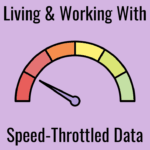


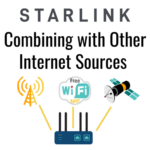

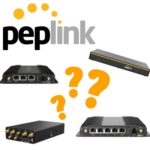
 Mobile Internet Resource Center (dba Two Steps Beyond LLC) is founded by Chris & Cherie of
Mobile Internet Resource Center (dba Two Steps Beyond LLC) is founded by Chris & Cherie of